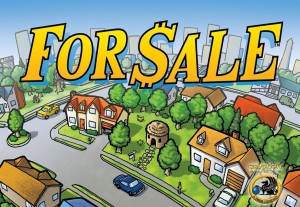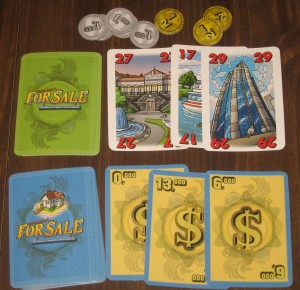So, I was taking a look at some of my older reviews…especially the ones that weren’t published with the format that I’ve come to adopt and enjoy. I admittedly bashed “For Sale” pretty hard and based on suggestions from the community, I’ve decided to take another look at the game to see if my opinion about it has changed. Let’s take a quick look at what the game is about and how it plays.
Components
Cards – The cards in this game consist of money cards and property cards. Property cards have values on them ranging from one to thirty, while the money cards have values on them ranging from $0.00 to $15,000. There are values of the same type in the money deck but not in the property deck.
Coins – These coins are primarily used for bidding purposes.
Setup & Gameplay
First, everyone receives a certain amount of plastic coins. Both decks are shuffled and some cards are randomly removed, depending on how many people are playing.
Phase one of the game involves the property cards. A number of property cards are flipped up, based on how many are playing. If four people are playing, then four property cards per round will be flipped up. Players take turns bidding with their plastic chips in clockwise order. The first player to pass gets the lowest valued card on the table and half their bid back. The second player to pass gets the second highest and half their bid back…and so on and so forth. The person with the highest bid gets the highest valued property card, but does NOT get half their bid back. Players rotate on who starts the bid every round, until all property cards are owned by the players. This stack of cards now in their possession forms their hand.
Phase two of the game involves the money cards. A number of money cards are flipped up, based on how many are playing. Each person looks at the money cards currently on the table that round and must decide which property card is worth playing. Players pick a card from their hand and place it face down on the table, revealing them all at once. The highest property card value gets the highest money card on the table, second highest property card value gets the second highest…you get the idea. Rounds continue until all money cards are owned by the players.
Players count their money cards and any leftover coins from phase one. Whoever has the most money wins!
The above is just an overview of the rules, but should give you an idea as to how the game is played. For more information, please check out the links posted at the end of this article.
Review
The components are pretty well made and are attractive to boot. The colors and the art style were eye-catching from a distance, and the box insert holds all of the components well. With that said, the group didn’t seem to enjoy the game our first time around. Jen (my other half), who doesn’t sit in on our gaming sessions all that often, found the game to be boring. She began picking cards willy-nilly at one point, which pretty much spelled the end to game night. She even made the comment: “I’d rather tie my shoes twenty times in a row rather than play this game again.” Ouch.
What I found odd is that she enjoys “Lost Cities”…so it’s not like she an anti-gamer by any means of the definition. I’m proud (and sort of ashamed) to admit that she’s put more hours into the video game “Dragon Age” than I have. So I have to ask myself, what happened? For one, she doesn’t like to think too much in the games she plays…she likes action, to put it simply. Dice rolling and simple move mechanics like those found in “Lost Cities”, “Sorry”, and “Trouble” are more attractive to her. I of course, don’t blame her for being this way…every person has a right to like what they like, end of story.
There is a bit of strategy involved in this game, one that requires you to pay attention to what cards have been played and what cards you’re currently bidding on. I found the game to be ingenious at what it does, but it may not appeal to everyone. Everyone in the group needs to be onboard with the strategy and bidding mechanics…and as proven by our first play session, one dissatisfied player can make or break the experience. Personally, I found the game to be fun to play…simple and quick for an experienced gamer. If I can find the right group of folks to play it with, I have a feeling I’d enjoy bringing it out of my closet more than I do.
In the end, I do recommend giving “For Sale” a shot…but it’s important to consider the type of people you plan on playing with. If they don’t mind thinking a little, bidding on cards, and reading other players’ tells, then this may very well be a big hit in your household. It requires three or more players, but is friendly enough for kids of most ages. “For Sale” is a solid card game and would serve as an excellent filler on game nights.
Final Verdict: 7/10
—
You can learn more about “For Sale” by visiting the following websites:
http://boardgamegeek.com/boardgame/172/for-sale
—


